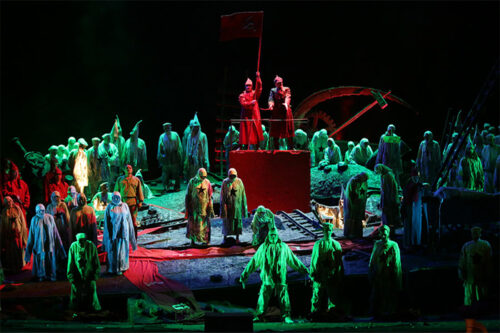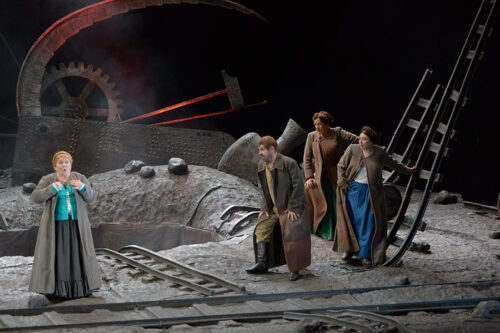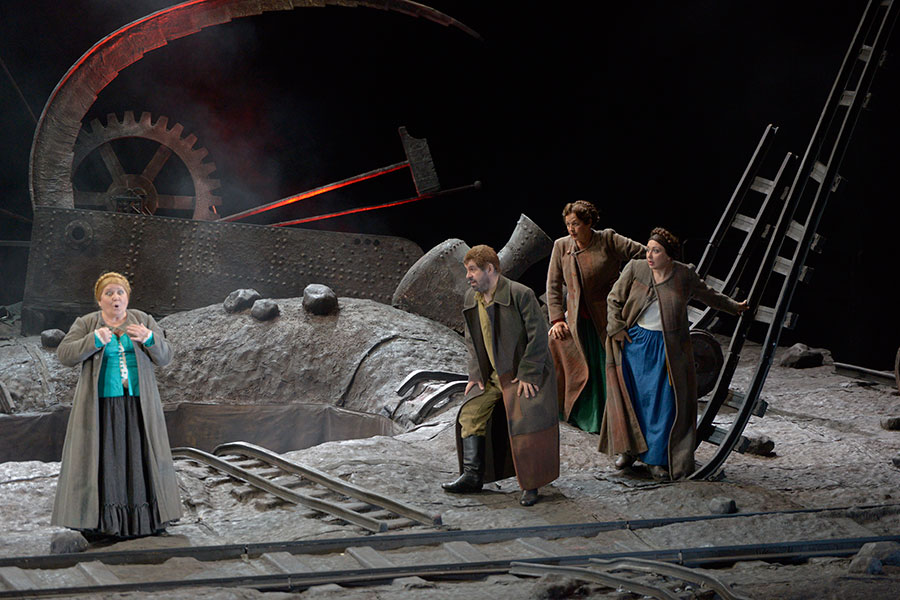 Russian Federation Prokofiev, Semyon Kotko: Soloists, Chorus and Orchestra of the Mariinsky Theatre / Valery Gergiev (conductor). Mariinsky II, St Petersburg, 23.10.2021. (GT)
Russian Federation Prokofiev, Semyon Kotko: Soloists, Chorus and Orchestra of the Mariinsky Theatre / Valery Gergiev (conductor). Mariinsky II, St Petersburg, 23.10.2021. (GT)

Production:
Director – Yuri Alexandrov
Set designer – Semyon Pastukh
Costume designer – Galina Solovieva
Lighting – Gleb Filshtinsky (adapted for Mariinsky II by Kamil Kutiyev)
Choreography – Gali Abaidulov
Choirmaster – Konstantin Rylov
Conductor of the Stage Orchestra – Nikita Gribanov
Cast included:
Semyon Kotko – Sergey Semishkur
Mother of Semyon – Lyubov Sokolova
Frosya – Yekaterina Krapivina
Sophia – Zhanna Dombrovskaya
Remenyuk, Chairman of the Village Soviet – Yuri Nikitin
Tkachenko, a kulak – Andrey Serov
Khivrya, Tkachenko’s wife – Nadezhda Vasilyeva
Tsarev, a sailor – Roman Burdenko
Lyubka, Tsarev’s fiancée – Ekaterina Solovieva
Ivasenko – Mikhail Kolelishvili
Mykola – Stanislav Leontyev
Klembovsky – Oleg Balashov
Von Virhov, a German Ober-lieutenant – Vladimir Samsonov
Of his nine completed operas, Sergey Prokofiev composed only two on Soviet themes – Semyon Kotko (1939) is based on Valentin Katayev’s 1937 novel ‘I, a Son of the Working People’, which was popular enough to inspire a children’s feature film – ‘A Soldier walked from the Front’. His final opera The Story of a Real Man based on Boris Polevoi’s 1947 is a true-life story about a pilot who loses his legs in battle yet returns to fly again. Semyon Kotko was to be a collaboration with the great stage director Vsevolod Meyerhold – with whom Prokofiev had enjoyed a friendship from his 1916 opera The Gambler, and The Love of Three Oranges of 1919 – neither of which could be staged by Meyerhold. Another casualty in their collaborations was Prokofiev’s ballet Le pac d’acier which was banned in 1930. Following the closure of Meyerhold’s theatre in 1937, Stanislavsky appointed him as director of his theatre and Semyon Kotko was to be staged there – yet following the tragic arrest of Meyerhold and his murder – the opera’s production did not take place until 23 June 1940 under the direction of Serafima Birman – a celebrated actress of the period. The staging was not a success as the scenario had to be switched from the narrative of German invaders to Ukrainian nationalist usurpers owing to the ill-fated German-Soviet Non-Aggression Pact.
The 1940 production was admired by Nicolay Myaskovsky, and notably by Svyatoslav Richter, who was convinced of the composer’s genius only after seeing the opera. The opera dates from a richly fruitful period after Peter and the Wolf, the three great war piano sonatas, and the Alexander Nevsky cantata. Certainly, after its premiere in 1940, it enjoyed more than 280 performances in Brno, Leipzig, Dresden, Sofia, Ostrava and Prague as well as in several Soviet cities, prior to its Bolshoi Theatre premiere in 1970. The Kirov Theatre only staged Semyon Kotko in 1960, while under Valery Gergiev, a new production was unveiled on 8 June 1999. The opera was positively received at Covent Garden when the Mariinsky Opera brought the production to London in June 2000. My acquaintance with this opera has been limited to old mono LPs of the first recording in 1960 under Mikhail Zhukov – the conductor of the 1940 premiere, and it could not prepare me for this outstanding and brilliantly written stage work.
The story line is about a soldier Semyon Kotko (Sergey Semishkur) who after four years fighting in the Great War returns to his impoverished village in the Ukraine to marry his fiancée Sophia (Zhanna Dombrovskaya), yet he finds that the kulak Tkachenko (Andrey Serov) wants his daughter to marry a wealthy suitor Klembovsky instead. Sophia however rejects her father’s plans, and they go ahead with their ceremony. In the evening, the three couples – Semyon and Sophia together with Mykola (Stanislav Leontyev) and Frosya (Yekaterina Krapivina) and Tsarev (Roman Burdenko) and Lyubka (Yekaterina Solovieva) spend a balmy night in the gardens – which is portrayed as a ballet scene. The plot thickens when German troops invade and hang several villagers, including Tsarev and Ivasenko. Semyon and his friends become partisans and avenge the killing of their friends and the village is liberated by the Red Army and partisans. Finally, Semyon and Sophia are free to marry, and the opera closes on a happy, joyous note.

Semyon Pastukh’s sets resemble a devastated war zone of scattered railway tracks, an up-ended locomotive and a mill in the background on which the wheels form a hammer and sickle. The central circular pit transforms into a garden, or a pond, or a church at periods during the performance, and there are hatches which open and allow actors and singers to emerge or to disappear. This set allows for speedy changes from scene to scene with no halt to the swiftly moving drama. The costumes were typically military for the period of 1918 Ukraine, with more bizarre costumes for the Red Guards either of red gowns with tall caps, or for German soldiers and Cossack costumes.
Prokofiev’s score is often strikingly beautiful and lyrical in many passages, and particularly in the scene in Act III, when the three couples dance in the moonlight, and the accompaniment by the violin of Anton Kosmin and the harp of Elena Klass was beautiful in bringing out the romanticism. This contrasts with the execution scene and hanging of the three Bolsheviks with their grim figures hanging above the stage. There was also the capture of Lyubka, her rape and her delirious weeping after the death of her fiancée by the Germans. There were explosively dramatic moments in the destruction of Semyon’s home, the village, and later in the burning of the church. At the close of the opera, following the entry of the Red Guards and Partisans, the scene was equally striking with the Red Guards now dressed in grey suits and holding little red books with a huge bust of a politician – probably Lenin. Typically, the final chorus of Red Guards and partisans is joyful and celebratory with what might be an unusual text in a Russian opera – ‘In free Ukraine, the horses are flying. Flying forward in perfect order, flying forward in order, flying in a fiery determined order’. To conclude, a quintet sings, ‘In free Ukraine, on its blue steppe the partisans are moving, Forward! Forward! Forward!’
Of the singers, I was most impressed by the Semyon portrayed by the lyrical tenor of Sergei Semishkur for his magnificent voice and character portrayal. In the female parts – the characterisation of Semyon’s sister Frosya, by the mezzo soprano Yekaterina Krapivina was spectacular – she sang several gorgeous arias, such as, ‘Raindrops are falling…’ in Act I Scene 8, and later in Act IV ‘O, people, good people…’. The Sophia of the soprano Zhanna Dombrovskaya was memorable especially in her aria ’Where is there truth in this world?’ The challenging role of Lyubka from the soprano of Yekaterina Solovieva – portraying both young love and demented agony – was moving in her singing of ‘You gave me your word…’ and later, after Tsarev is killed, ‘No, it’s not Vasilek, no, it’s not Vasilechik…’ The Remenyuk of the baritone Yuri Nikitin impressed in his solid presence, gravity and vibrant vocal singing, and his contribution was equalled by the wicked father-in-law of Tkachenko by bass Andrey Serov.
All the secondary roles were admirably performed, and the choral singing was super meshing with the choreography on stage in the striking mass scenes involving the Red Guards (‘We swear an oath’) and – notably in the finale of Act V (‘As I die, bury me in a grave in the Kurgan, in the broad and dear Ukraine’). There were several spectacular scenes; in the ‘Red Wedding’ with two contrasting ceremonies, one religious, and the other a simple Bolshevik ritual, also in the scene of the burning village with German troops, and weeping villagers. There are no real weaknesses in Prokofiev’s opera – the vocal lines are often beautiful and albeit criticisms can be made in that it is purportedly ‘socialist realist’, in truth, it is story about young people in love, whose fates are threatened by the consequences of war. The scenes with red flags are no more disturbing than many operas of the last two hundred years which have political themes present. An interesting theme is the use of Ukrainian jargon in the libretto, and the use of the Ukrainian nationalist poet Taras Shevchenko’s poem in the choral singing.
The director Yuri Alexandrov said of his staging of Semyon Kotko: ‘History can neither be bad, nor good – it is our history. A history of brother fighting his brother, about a daughter betraying her father, about people losing their homeland in the bloody storms of the Civil War.’ In preparing the opera, they decided not to change either text or subject, ‘Someone suggested removing text “Long live Lenin,” but we rejected this idea because this is our history, our “Richard the Third”.’
Of all the Russian operas which are performed in the West, apart from Tchaikovsky’s Eugene Onegin and The Queen of Spades, of the Soviet repertoire, only Shostakovich’s Lady Macbeth of Mtsensk enjoys any frequency in opera theatres, while Prokofiev’s War and Peace needs a large cast and is only rarely staged. Prokofiev’s Semyon Kotko has suitably attractive music, vocal writing and a good story line (there are little politics in it surprisingly!) and is from a richly productive period in Prokofiev’s career and deserves much more exposure in the West. Vladimir Jurowski conducted the opera in the Netherlands in 2016 to great success but it was not revived. That Semyon Kotko is in the repertoire of the Mariinsky Theatre is largely due to Valery Gergiev who once again gave a tremendous performance of a neglected but great opera.
Gregor Tassie
